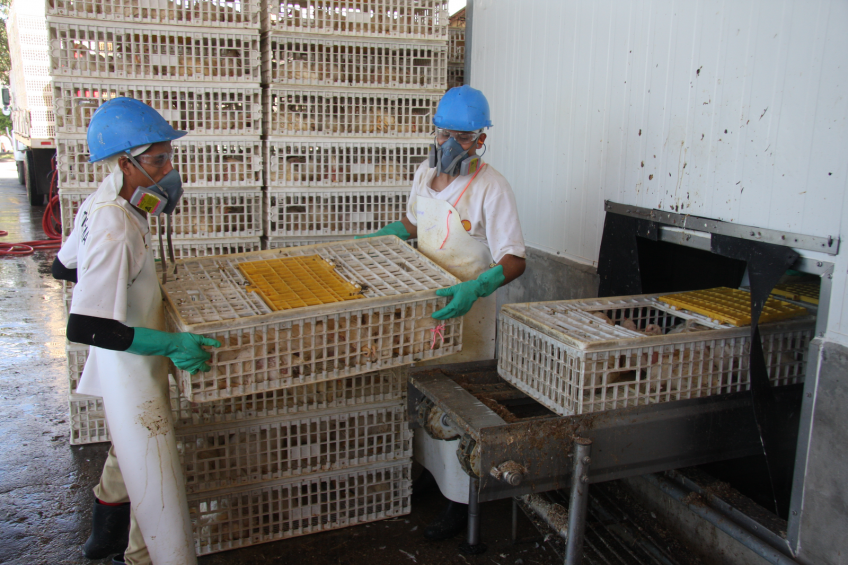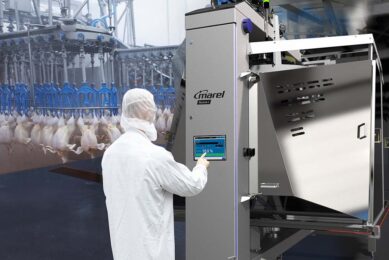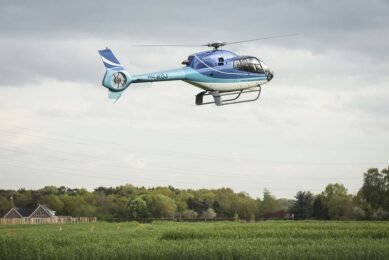Smoothly moving broilers from farm to shackle

Market-age broilers are moved to the plant to be slaughtered across a set of operations, known as pre-slaughter. This embraces crating, live hauling, unloading and shackling. Taking these stages seriously, will guarantee acceptable working conditions and animal welfare standards.
By Fabio G. Nunes, Poultry Processing Consultant, Brazil
There are two systems that can be used to contain live broilers on their way to the plant: plastic crates and containers, which can be of stand-alone or drawer types.
Plastic crates are a relatively low-cost capital investment and still are a very common means to pack live broilers for transportation around the world. Crates are modular and made of plastic parts. Therefore they are easy and cheap to maintain in case of damages. They are stalwart, durable and the fully slotted walls and floor offer plenty aeration of the live load, thus reducing the risk of in-transit mortality.
Although there’s slight variation among manufacturers, the crates’ net volumes are pretty much similar and, according to live weight, can easily accommodate six to 12 birds up to the limit of 25 kg/crate. This limit is usually set by the companies for animal welfare reasons.
Light weight material
Crates are made from compact and light weight material, thus making it easy for the catching crew to de-stack, handle and move them around the house manually when collecting the broilers. Their top flip- or sliding doors offer a wide opening to move broilers in with reduced risk of damage and in a comfortable, ergonomic way for the crew. However, loaded crates are hard to handle, to re-load and to stack back onto a truck, a naturally exhausting work that may become even worse under hard weather conditions. Therefore, companies must properly dimension the catching crew and the catching schedule, besides providing supportive resources, to minimise the fatigue associated with the job.
Keeping the crew’s morale high is crucial, enabling them to handle the birds gently throughout the whole catching. Live haulers for the crates are usually adaptable to the limitations imposed by road services and landscape in some parts of the world, thus varying in size from two through to six axles.
It is advisable to install a canvas cover at 0.5 m above the entire load, to protect the top birds from the direct sunlight and reduce the risk of mortality. As an additional protection measure against in-transit heat stress, companies customarily shower the live load prior to leaving the farm, allowing for evaporative cooling of the birds.
Containers more ergonomic
Containers are considerably more expensive and require an extensive supportive infrastructure in the chain between farm and plant: large trucks, fork-lifts, an unloading platform and discharging dock. Crates are roomy and can easily accommodate 400 birds at a time, as the fully slotted walls allow for good ventilation of the live load all the time. Made of steel, they are stalwart, however they are most likely to rust, thus demand a more frequent maintenance.
At the farm, drawer containers allow for an ergonomic loading work and the smooth, gentle handling of birds, as opposed to front flip-door containers whose loading work is ergonomically difficult for the crew and physically much riskier for the birds. In the stream of the asymmetry between the systems, each class of container requires the proper dimensioning of the catching crew and the catching schedule. The logistics of the empty and loaded containers at farm demands a fork-lift. As containers, live haulers are large, appropriate roads and good farm infrastructure are important prerequisites to ensure its easy manoeuvrability and reduce the risk of accidents.
First come, first served
Upon arrival at the plant, trucks are weighed before heading to the holding shed to protect the live load from the direct sunlight while waiting to be slaughtered. Trucks must be scheduled for slaughter on a “first come, first served” basis, unless any major event justifies a change in this order.
Trucks unloading can be either semi-continuous, first placing the crates piles onto the platform and further dragging them down to the hanging station, or continuous, by discharging the crates directly onto a conveyor belt that will drive them straight into the hanging area. By either means, the operation is very gentle and offers no significant risk to the physical integrity of the live birds.
Emptying containers
Containers are first moved from the trucks onto the discharging platform. In drawer containers, these are gently pushed out from the steel frame and placed smoothly onto a conveyor, which moves them straight into the shackling station.
Standalone containers, in turn, are angled down to dump, like a cascade, the live and fragile content onto a conveyor belt, which transports the birds standing on their feet to be shackled. Different from the two preceding methods, the dumping system is the most damaging unloading method for the birds, whose wings are often the most affected, damaged parts. Largely used by the poultry industry around the world, despite the risks to the birds, the container dumping system seemingly has a long life ahead.
Thorough cleaning
Empty crates, drawers and containers must be thoroughly washed and disinfected prior to being re-used, thus minimising the risk of cross-contamination among farms. From the hanging station, plastic crates and drawers are first dragged across a hot-water bath to soften the debris attached to their surface, and then proceed to the washing and rinsing machines to finally be disinfected prior to being re-stacked onto the trucks. Steel containers are likewise thoroughly washed and disinfected prior to moving back onto the trucks. Detergents and disinfectants used in the sanitation must be effective against the pathogens and likely compatible with the different materials they are in contact with, to prevent crates and, mostly, the steel containers to wear down over time. American researchers at the USDA’s Russell Research Center and University of Georgia demonstrated that washing alone does not eliminate pathogens, like Campylobacter for instance, from the containers’ surface. Their research showed that containers must be washed and further dried as to bring the pathogens count to innocuous levels, therefore eliminating the risk of cross-contamination during live haul. Given the time-demanding natural drying process, they suggest using hot flowing air to speed up the process.
Hanging hazardous
The design of the live hang area and nature of the work pose risks to workers, says the Human Society of United States (HSUS) in their report: “Human Health Implications of Live Hang of Chickens and Turkeys on Slaughterhouse Workers”. Live hang workers must continuously reach down approximately to waist level to grab birds from a moving conveyor belt and then shackle them on a line moving in the opposite direction. One hazard of this system is the possibility of ensnaring a gloved finger in a moving shackle. Other hazards include the disorienting effect of keeping pace with high-speed conveyors running in opposite directions and shoulder, back, and neck strain because of awkward postures and repetitive motion, says the report. Live hang also requires that workers stand for long periods of time on hard surfaces, which can lead to fatigue and pain in their lower back and legs. This is exacerbated by the fact that the rubber boots typically worn by these workers provide little to no arch support.
The International Labor Organization (ILO) in its paper “Poultry Processing”, by Tony Ashdown, endorses that the “hanger’s job is extremely stressful from both a physiological and psychological standpoint. Reducing workload could lessen this stress. The constant grabbing with both hands, pulling in and simultaneously lifting a flapping, scratching bird at shoulder or head height is stressful to the upper shoulder and neck. Therefore, minimising the bending and lifting required could improve performance and retention while decreasing medical claims”.
Reduce stressors
As could be seen, the ergonomics of the hanging station is an important prerequisite to guarantee the well-being of the workers and the quality of the live birds shackling, for its consequences to the stunning, bleeding and, further down, to scalding and plucking. Ergonomics can be defined simply as the study of work, or more specifically, the science of designing the job to fit the worker, rather than physically forcing the worker’s body to fit the job. Adapting tasks, work stations, tools, and equipment to fit the worker can help reduce physical stress on a worker’s body and eliminate many potentially serious, disabling work-related musculoskeletal disorders (MSDs). In the stream of this definition, companies must adapt the shackling station to the workers by harmonising the height of the conveyor belt. This is the height and distance of the overhead conveyor and workers’ average stature that must be standardised. Ashdown says that “an extremely important element to ensure the worker’s health is a proper job conditioning programme. For a period of up to two weeks, a new hanger must be acclimated to the conditions and slowly work up to a full shift. Another key ingredient is job rotation. After two hours of hanging birds, a hanger may be rotated to a less strenuous position. Some plants have tried double crewing to allow crews to work for 20 minutes and rest for 20 minutes, to reduce the ergonomic stressors”.
Creating good conditions
Set hangers’ crew size to match the line speed and live weight. Use a colour-coded shackle as the hanging-pace setter, assuring a comfortable, homogeneous hanging and careful handling of birds along the shifts. Provide them personal protective equipment – goggles, dust mask, gloves, aprons and uniform – and enforce its use. Guarantee the hanging room counts on proper illumination and good air quality. By adopting these suggestions companies will be minimising the impact on workers resulting from the physically demanding, repetitive work and the harsh environment, therefore protecting their health, keeping their mood high while securing the careful, smooth handling and shackling of the live broilers.
Gentle and fast shackling
For animal welfare and quality purposes, hangers must be trained to suspend live birds carefully from crates, drawers or the conveyor belt by the legs, not wings, and clamp their shanks, not the legs, when shackling. Broilers live weight and shackles’ gauge must match to allow for a gentle and fast shackling, hence preventing birds from suffering, hocks from damages and settling all feet at the very bottom of the shackles, a prerequisite for a consistent stunning. For animal welfare reasons, spikes on the shackles used to perforate the feet yellow skin, enhancing the feet-shackle contact and boosting the stunning is no longer allowed. For optimal results, audit the work, retrain the team, if necessary, and gauge the shackles periodically.
Install a smooth-surface breast panel from the hanging station to the stunner’s entrance and secure this track of overhead conveyor is straight, free from curves, ascents and descents. The panel and the straight line have a proven calming effect on hanging birds, therefore reducing the stress and the consequent wing flapping and damages. Birds should be stunned no later than within 20 seconds after hanging, and for animal welfare reasons, they are required to be un-shackled in the event of a line stoppage longer than one minute.
Economic impact of DOA’s
Dead on arrival birds (DOA’s) are of economic and animal welfare concern and present poultry companies with a triple-edged challenge: understanding the economic loss, determining causes of DOA’s and finding ways to reduce the numbers.
In some countries official regulations require that poultry companies register the number of DOA’s, while in some others not. Therefore, the economic impact of DOA’s is sometimes overlooked or underestimated by the poultry companies. However, it may be financially very significant when measured on a yearly basis. Below we see the impact of every 0.1% DOA on a typical poultry operation:
- 1,250,000 birds/week x 0.1% DOA = 1,250 DOA/week
- 1,250 DOA/week x 2 kg LW = 2,500 kg DOA/week
- 2,500 kg/week x 52 weeks/yr = 130,000 kg DOA/year
- 130,000 kg DOA/year x 70% yield = 91,000 kg/year of lost saleable weight
While the grower is typically compensated for DOA’s, the processor will incur a loss of salable product as seen before. DOA’s may be caused by various factors that impact the physical and physiological status of birds, therefore are likely an indicator of poor animal welfare. DOA’s attributed to on-farm factors include birds that have a compromised health status or disease conditions that may trigger death loss when coupled with catching and live-haul stresses. DOA as a result of physical trauma, heat stress and asphyxia during catch and transit to the processing plant are considered live haul-related. Finally, plant-related DOA’s are birds that die from trauma or asphyxia during off loading at the plant and are caused by damaged cages, malfunctioning equipment and dump operator error. Understanding the causes of the problem will assist in providing strategies to reduce its magnitude, nonetheless preserving the company’s bottom line and guaranteeing a high standard of animal welfare.
References are available on request from the author
Join 31,000+ subscribers
Subscribe to our newsletter to stay updated about all the need-to-know content in the poultry sector, three times a week. Beheer
Beheer








 WP Admin
WP Admin  Bewerk bericht
Bewerk bericht